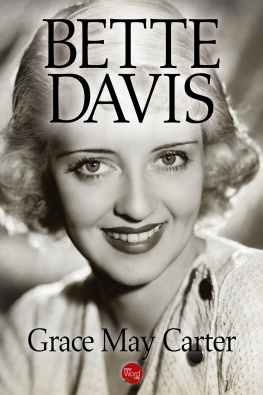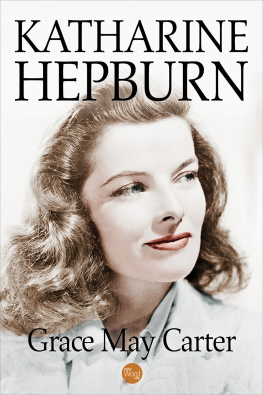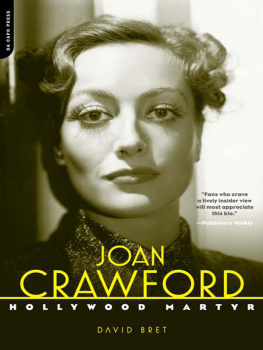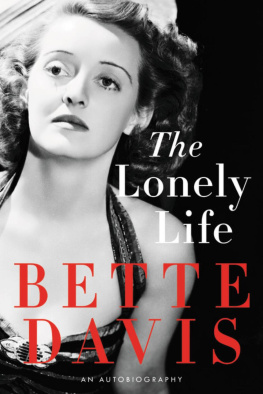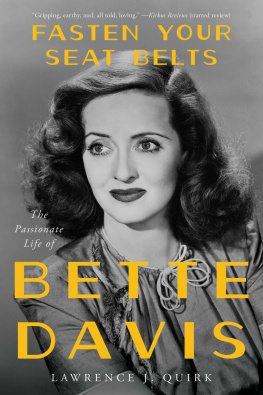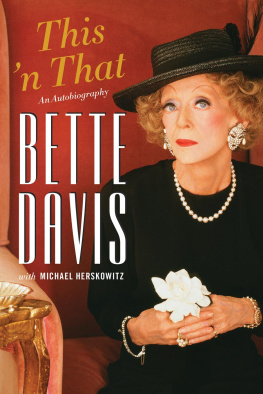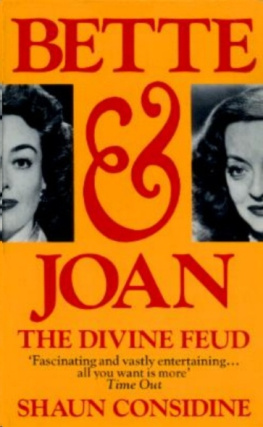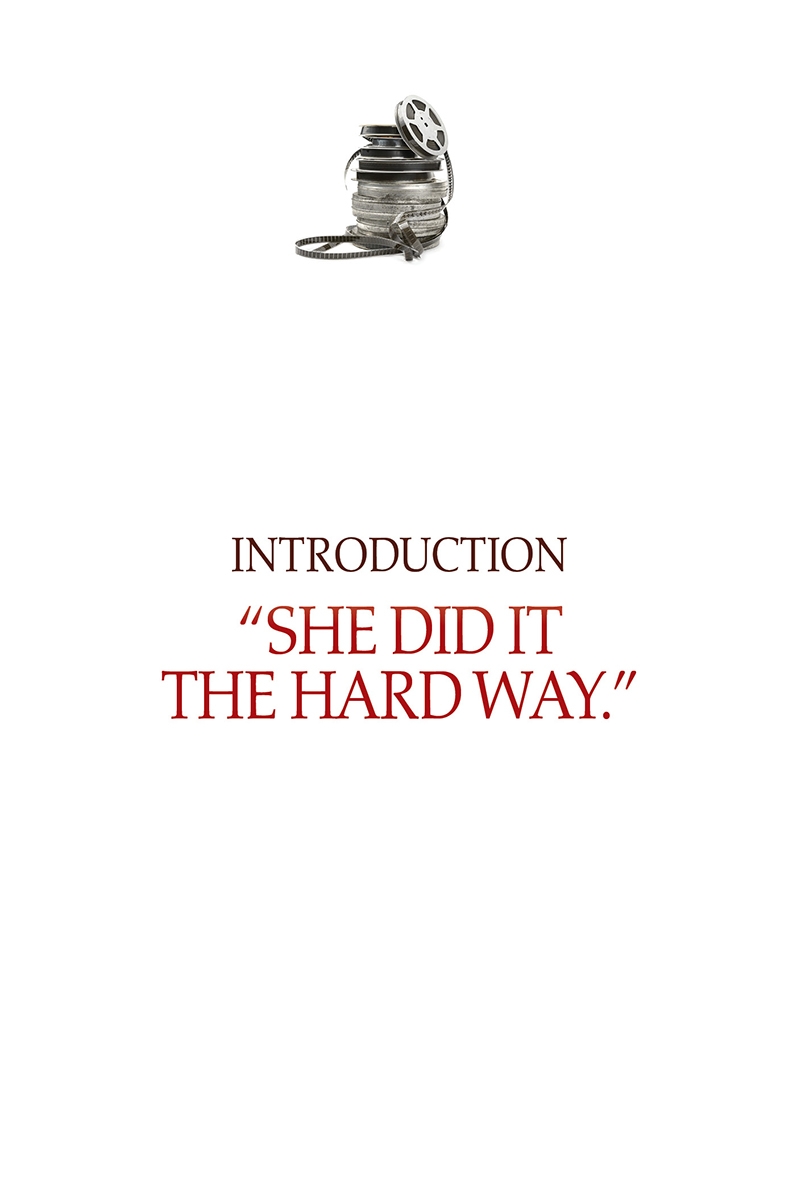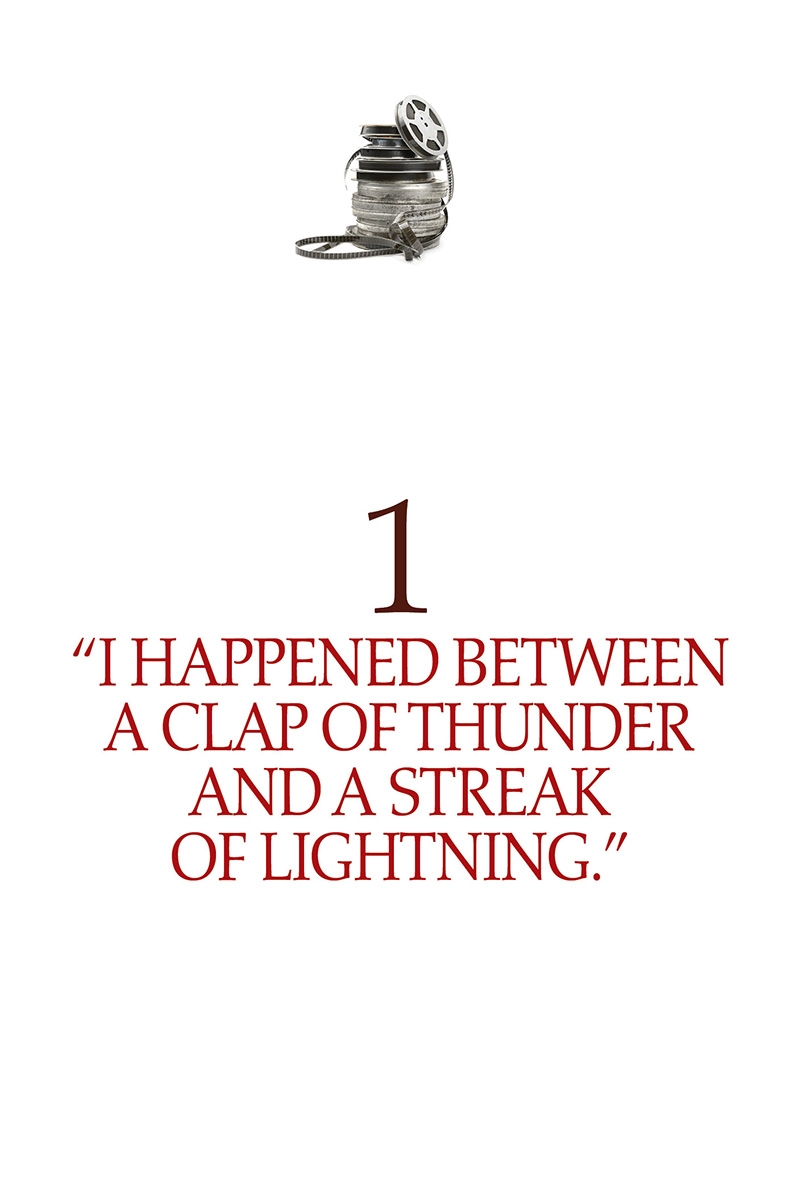In the course of a career that spanned six decades (from 1931 to 1989), more than 100 films, two Academy Awards, and ten Oscar nominations, Bette Davis became one of the greatest screen icons of all time. But her off-screen life was filled with drama and heartache. Even the title of her autobiography reflected the pain of her tumultuous existence.
It was called The Lonely Life .
Little came easily to Bette. Despite her success, she had to fight for first-rate roles and the directors that went along with them. She also struggled with addictions - alcohol and cigarettes, in particular. Married four times, she lived, for a while, under a cloud of suspicion after the only husband she didnt divorce died following a freak accident. She had three children, but even they brought her pain and controversy. Her eldest, B.D. Hyman, wrote a scathing, tell-all book in 1985, leaving permanent scars on Bette and her family; her second child, Margot, suffered a brain injury and had to live in an institution; her third, Michael, was the subject of a prolonged custody battle between Bette and her last husband, the actor Gary Merrill.
Despite such tribulations - and the fact that most of the films she appeared in bombed at the box office - Bette Davis managed to become, in the words of New York Times critic Terrence Rafferty, nothing less than the greatest actress of the American cinema. During the 1930s and 1940s, when she was in her prime, she created a series of unforgettable characters - including the femme fatale Mildred Rogers in Of Human Bondage and the repressed spinster Charlotte Vale in Now, Voyager - and won Oscars for both Dangerous (1935) and Jezebel (1938). In 1950, she gave what many consider her finest performance, as the aging Broadway star Margo Channing in the classic All About Eve. Said Rafferty: She was as electrifying as Marlon Brando in the fifties: volatile, sexy, challenging, fearlessly inventive. She looked moviegoers straight in the eye and dared them to look away.
What made Bette stand out was her fierce desire to play characters who behaved badly - even sadistically or brutally - at a time when most actresses were preoccupied with their appearance. The cornerstone of my career in films was the power for action with which all women identified, Bette said once. When I portrayed evil on the screen, the women of the world were purged of suppressed violence and sheer boredom.
Clearly, Bette was not a conventional star. She wasnt a great beauty like Marlene Dietrich, Greta Garbo, or Jean Harlow. (Bette had a fat little Dutch girls face and a neck thats too long, said her first makeup man.) But she had something far more important: a restless, incandescent energy that made her mesmerizing on the big screen. As the British novelist and critic E. Arnot Robertson said, She gives the curious feeling of being charged with power which can find no ordinary outlet.
And then there were those eyes. For some, they were freakish - bug eyes declaring a strangeness that beguiled and fascinated, said film historian Elaine Lennon. To others, they were sexy and bewitching, immortalized in the Kim Carnes song, Bette Davis Eyes, which became a hit in 1981 and introduced Davis to a new generation of fans.
Her long career showed that transcendent acting and a distinctive look mattered far more, in the end, than the ephemeral allure of conventional beauty. In her fifties, Bette proved her staying power with roles in the popular horror films What Ever Happened to Baby Jane? (1962) and Hush... Hush, Sweet Charlotte (1964). But even in such movies, later regarded as camp classics, her artistry shows through. Bette did not disappear into a role; rather, her characters always reflected the larger-than-life personality of the actress who created them. That included her many quirks, such as strutting forcefully into a scene, clenching her fists, and making masterful use of those mysterious, darting eyes. Davis was a vulgar, bullying actress who made mannerism a virtue by showing us how it expresses the emanation of the self, wrote Peter McNally in his book, Bette Davis: The Performances That Made Her Great.
Her later horror films helped turn Bette into an icon, in among other things, Americas gay subculture. But in the eyes of some critics, such fame did not help her reputation as a serious artist. Was she just a camp figurehead because her brittle, melodramatic style of acting hadnt aged well? asked the journalist Jim Emerson. Or was it that she was Larger Than Life, a tough broad who had survived? Probably some of both.
As Bette grew older, that sense of survival became her hallmark. In her seventies, she forged ahead and continued to make movies and television shows despite health setbacks, including breast cancer and a stroke that left her partly paralyzed. As she put it, in perhaps her most famous quote, Old age aint no place for sissies. She smoked a hundred cigarettes a day and died in 1989 at the age of eighty-one.
She was a magnificently talented actress, but the emotional baggage she brought with her was awesome, said producer William Frye, writing in Vanity Fair magazine in 2010. Those personal issues manifest in her constant, vicious battles with directors, studio chiefs, producers, co-stars, husbands, and children were on full display in her two memoirs, the first published in 1962, the second in 1987. She also contributed to a 1974 book by Whitney Stine called Mother Goddamn, a name from one of her movies that Bette adopted for herself and encouraged her children to call her.
Among her adversaries in her legendary Hollywood feuds were a whos who of motion-picture history: Miriam Hopkins, Errol Flynn, and her arch-nemesis, Joan Crawford. Her affairs with prominent men were waged just as passionately; her romantic conquests included the eccentric tycoon Howard Hughes, songwriter Johnny Mercer, and her favorite director, William Wyler.
And yet, even to those she fought with and loved, Bette remained something of an enigma. Her life was bold and punchy, full of contradictions, wrote the film critic Rex Reed. Distant yet intimate, bitchy yet humane, controlled yet flamboyant, a firebrand longing for domesticity, she bristled with the kind of neurotic tension that is often mistaken for creative energy.
Near the end of her life, she became even more caustic, nearly a parody of herself. As her drinking increased, she tossed off nasty letters to friends and settled old scores. Through it all, though, she had few regrets. Reflection and self-doubt were never her style. Being hysterical is like having an orgasm, she once said. Its good for you.
How the baby girl born Ruth Elizabeth Davis in Lowell, Massachusetts, in April 1908 became the legendary Bette Davis is a fascinating tale rich with intrigue, passion, and surprising plot twists. Like any good story, it has plenty of conflict, much of it created by a protagonist who always delighted in a good fight. I have been at war from the beginning, she wrote in her autobiography. I rode into the field with sword gleaming and standard flying. I was going to conquer the world.
Given what is now known about Bette Davis, it should come as no surprise that she emerged from a long line of strong-willed women. Her grandmother on her mothers side, Eugenia Favor, was five feet of TNT, Bette once said. With little patience for idle hands and minds, Eugenia insisted that her four children Paul, Ruth, Mildred, and Richard take piano lessons, read Emerson, Wordsworth, and the Bible, and obey her commands without question.

